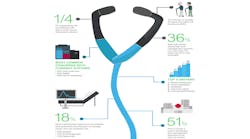Survey Finds Healthcare Facility Power Systems Unequipped for Digital Age
According to a new study commissioned by Schneider Electric, healthcare facilities are missing opportunities to reduce energy use and costs, avoid outages, and improve patient satisfaction because their power distribution and management systems are not equipped to take advantage of the Internet of Things (IoT) and other advanced technologies. The survey of 150 healthcare executives and facility managers underscores the importance of reliable power distribution and management in healthcare facilities and highlights the opportunity to integrate IoT-enabled power solutions to better meet health facility objectives.
On average, more than one-third (36%) of respondents — who represent hospitals, health systems, doctors’ offices and clinics, and other healthcare facilities — indicated their power distribution and management systems are more than five years old. Among respondents from hospitals, more than half (51%) report their power systems are at least five years old. Not surprisingly, those same facilities report greater concern with power availability and reliability and energy efficiency from their current power systems than larger organizations.
Health facility leaders recognize the critical role reliable power plays in delivering quality patient care and satisfaction. The survey found more than half (51%) of respondents plan to invest in power distribution and management in the next 12 months. Among the top objectives driving this investment is patient satisfaction, cited by 84% of respondents as being important or very important. Power availability and reliability, improved safety, and financial performance were also among the top anticipated benefits to be derived through advanced power systems.
Despite the benefits advanced power solutions can deliver, just 18% of respondents have implemented significant IoT-enabled and connected technologies to manage power distribution in their facilities. Budget limitations, cited by nearly half of survey respondents, are a major obstacle for healthcare facility leaders looking to implement new power solutions. Beyond budget, there is also a clear knowledge gap with around 15% of respondents citing lack of knowledge and resources to build and maintain advanced power systems.
With the rapid advancement in IoT technologies, there is an opportunity for these facilities to retrofit or upgrade their systems with IoT-enabled solutions that can create efficiencies and improve energy and financial performance. Adding smart devices, such as sensors, digital power meters or power quality monitors to existing equipment is an affordable way to optimize power reliability and maintenance and can pave the way for intelligent power distribution.
Overall, around one in four respondents is not satisfied with their current power distribution solution. For healthcare facilities of all sizes, the three most common concerns with current power distribution systems are energy use and cost reduction (23%), safety (22%), and power availability and reliability (20%). However, for leaders of smaller facilities, the top concern is energy use and cost reduction. In contrast, just one in 10 executives managing large facilities say this is a challenge for them, as they are more concerned with power availability and reliability (30%).
Demand for IoT-enabled or connected services such as real-time power monitoring or smart panels also varied by size of facility. In large facilities, 73% have implemented at least some IoT power solutions. However, demand amongst smaller organizations is much lower where around one in three facilities are not even considering this technology, highlighting a need for education about the opportunities and benefits smaller facilities can realize by integrating IoT in power systems.



